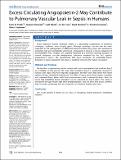| dc.contributor.author | Parikh, Samir Mukund | |
| dc.contributor.author | Mammoto, Tadanori | |
| dc.contributor.author | Schultz, Aylit | |
| dc.contributor.author | Yuan, Hai-Tao | |
| dc.contributor.author | Christiani, David C. | |
| dc.contributor.author | Karumanchi, Subbian Ananth | |
| dc.contributor.author | Sukhatme, Vikas Pandurang | |
| dc.date.accessioned | 2011-04-29T04:22:29Z | |
| dc.date.issued | 2006 | |
| dc.identifier.citation | Parikh, Samir M., Tadanori Mammoto, Aylit Schultz, Hai-Tao Yuan, David Christiani, S. Ananth Karumanchi, and Vikas P. Sukhatme. 2006. Excess circulating angiopoietin-2 may contribute to pulmonary vascular leak in sepsis in humans. PLoS Medicine 3(3): e46. | en_US |
| dc.identifier.issn | 1549-1277 | en_US |
| dc.identifier.uri | http://nrs.harvard.edu/urn-3:HUL.InstRepos:4879207 | |
| dc.description.abstract | Background: Acute respiratory distress syndrome (ARDS) is a devastating complication of numerous underlying conditions, most notably sepsis. Although pathologic vascular leak has been implicated in the pathogenesis of ARDS and sepsis-associated lung injury, the mechanisms promoting leak are incompletely understood. Angiopoietin-2 (Ang-2), a known antagonist of the endothelial Tie-2 receptor, was originally described as a naturally occurring disruptor of normal embryonic vascular development otherwise mediated by the Tie-2 agonist angiopoietin-1 (Ang-1). We hypothesized that Ang-2 contributes to endothelial barrier disruption in sepsis-associated lung injury, a condition involving the mature vasculature. Methods and Findings: We describe complementary human, murine, and in vitro investigations that implicate Ang-2 as a mediator of this process. We show that circulating Ang-2 is significantly elevated in humans with sepsis who have impaired oxygenation. We then show that serum from these patients disrupts endothelial architecture. This effect of sepsis serum from humans correlates with measured Ang-2, abates with clinical improvement, and is reversed by Ang-1. Next, we found that endothelial barrier disruption can be provoked by Ang-2 alone. This signal is transduced through myosin light chain phosphorylation. Last, we show that excess systemic Ang-2 provokes pulmonary leak and congestion in otherwise healthy adult mice. Conclusions: Our results identify a critical role for Ang-2 in disrupting normal pulmonary endothelial function. | en_US |
| dc.language.iso | en_US | en_US |
| dc.publisher | Public Library of Science | en_US |
| dc.relation.isversionof | doi:10.1371/journal.pmed.0030046 | en_US |
| dc.relation.hasversion | http://www.ncbi.nlm.nih.gov/pmc/articles/PMC1334221/pdf/ | en_US |
| dash.license | LAA | |
| dc.subject | cell biology | en_US |
| dc.subject | infectious diseases | en_US |
| dc.subject | emergency medicine | en_US |
| dc.subject | intensive care | en_US |
| dc.subject | respiratory medicine | en_US |
| dc.subject | critical care | en_US |
| dc.title | Excess circulating angiopoietin-2 may contribute to pulmonary vascular leak in sepsis in humans | en_US |
| dc.type | Journal Article | en_US |
| dc.description.version | Version of Record | en_US |
| dc.relation.journal | PLoS Medicine | en_US |
| dash.depositing.author | Parikh, Samir Mukund | |
| dc.date.available | 2011-04-29T04:22:29Z | |
| dash.affiliation.other | HMS^Medicine-Massachusetts General Hospital | en_US |
| dash.affiliation.other | SPH^Environmental+Occupational Medicine+Epi | en_US |
| dash.affiliation.other | HMS^Obstetrics Gynecology and Repro. Bio. - BIDMC | en_US |
| dash.affiliation.other | HMS^Medicine- Beth Israel-Deaconess | en_US |
| dash.affiliation.other | HMS^Medicine- Beth Israel-Deaconess | en_US |
| dc.identifier.doi | 10.1371/journal.pmed.0030046 | * |
| dash.contributor.affiliated | Karumanchi, Subbian | |
| dash.contributor.affiliated | Yuan, Hai-Tao | |
| dash.contributor.affiliated | Mammoto, Tadanori | |
| dash.contributor.affiliated | Parikh, Samir | |
| dash.contributor.affiliated | Sukhatme, Vikas | |
| dash.contributor.affiliated | Christiani, David | |


